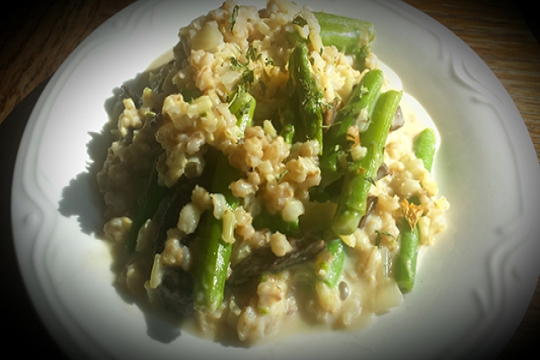Barley: The Original Passover Offering (barley is one of the seven species eaten on Tu BiSh'vat)
Before 70 C.E.—the year of the destruction of the Second Temple—Jews associated Passover not with matzah, but with barley, as the holiday was celebrated as a pilgrimage festival at the beginning of the barley harvest. Newly harvested barley could not be eaten until the first sheaves of grain were offered as a tithe to the Temple in Jerusalem on the second day of Pesach, which was then known as Hag Ha-Aviv (the holiday of spring). As Leviticus 23:10-11 states, “When you enter the land that I am giving to you and you reap its harvest, you shall bring the first sheaf of your harvest to the priest. He shall elevate the sheaf before the Lord for acceptance on your behalf.” Barley then served as the mainstay of the Jews’ diet because of the plant’s adaptability in Israel’s different climates and its resistance to dry desert heat. With God’s blessing, new barley crops would survive bad weather and thrive, averting famine in the land.
Ironically, the rabbis later categorized barley as one of the five chametz grains (along with wheat, spelt, rye, and oats) that were not kosher for Pesach!
This recipe is more nutritious than typical risotto and has that same risotto consistency, plus the natural starch in the barley grain adds creaminess to the dish. The use of saffron mimics the classic Risotto Milanese, which some connect to the Venetian Jewish community.
- Combine the broth and the crushed saffron threads in a 1-quart pot and bring to a simmer.
- Meanwhile, cut the asparagus stalks on a diagonal into 1⁄2-inch pieces, reserving 11⁄2 inches
of the tip. - When the liquid is simmering, drop in the asparagus stalk pieces and blanch for 2 minutes, until they’re bright green and slightly tender. Using a slotted spoon, transfer them to a small glass bowl. Add the tips to the broth and cook for 1 minute, then remove from the broth and set aside.
- Keep the broth warm over low heat while you prepare the barley.
- Heat a 3-quart saucepan over high heat for 10 seconds. Add the extra virgin olive oil and heat for another 10 seconds. Mix in the onion and garlic and reduce the heat to medium. Sauté the mixture for about 4 minutes, until the onions and garlic are slightly golden.
- Add the barley and stir to coat.
- Pour in the wine, stirring constantly until it is absorbed.
- Add all of the simmering broth, stir, then cover and reduce the heat to low. Stirring the mixture every 5 minutes or so to prevent sticking and burning, cook for 30–35 minutes, until the barley is tender. If all of the liquid has been absorbed and the barley appears too hard and/or dry, add another 1⁄4 cup of water and cook for 5 more minutes.
- Remove the pot from the heat. Stir in the salt, pepper, and lemon zest until well combined.
- Gently stir the grated cheese into the mixture. When it is evenly distributed and melted, add the almonds and the reserved asparagus pieces minus 5 asparagus tips.
- Immediately serve the barley risotto in a dish garnished with the reserved Tablespoon of almonds and the 5 asparagus tips.
- If you want an even richer consistency in any hot barley dish, add 1–2 Tablespoons of unsalted butter to the hot barley mixture before serving.


